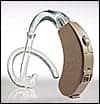Chicago — According to a new Journal of the American Medical Association (JAMA) study, treating idiopathic sudden sensorineural hearing loss with injections of steroids directly into the ear appears to result in recovery of hearing that is not less than recovery obtained with the standard therapy of oral corticosteroids and may be a preferable treatment for some patients to avoid the potential adverse effects of oral steroids.
Idiopathic sudden sensorineural hearing loss has an estimated incidence between 5 and 20 per 100,000 
In recent years, intratympanic corticosteroid treatment by direct injection into the middle ear has gained wide popularity. One theoretical advantage of intratympanic treatment is an increased drug concentration in the targeted area, with reduced systemic steroid exposure and associated systemic adverse effects that may accompany oral steroids. “However, no adequately powered prospective randomized controlled trial has compared oral and intratympanic steroid treatments to demonstrate that increased local drug concentration leads to improved hearing outcome,” the authors write.
Steven D. Rauch, MD, of Harvard Medical School, Boston, and colleagues conducted a multicenter, randomized, noninferiority (outcome not worse than treatment compared to) trial comparing the efficacy of oral prednisone to intratympanic methylprednisolone for primary treatment of idiopathic hearing loss. Noninferiority was defined as less than a 10-dB difference in hearing outcome between treatments.
The study included 250 patients with unilateral sensorineural hearing loss who presented for care within 14 days of onset of hearing loss of 50 dB or higher of pure tone average hearing threshold. Pure tone average (PTA) was calculated as the arithmetic average of the hearing thresholds at 500,1000, 2000, and 4000 Hz in the affected ear. The study was conducted from December 2004 through October 2009 at 16 academic community-based otology practices. Participants were followed up for 6 months. 121 patients received 60 mg/d of oral prednisone for 14 days with a 5-day taper and 129 patients received 4 doses over 14 days of 40 mg/mL of methylprednisolone injected into the middle ear.
The researchers found that improvement in PTA at 2 months in the intratympanic methylprednisolone group was not inferior to PTA improvement in the oral prednisone group. “In the oral prednisone group, PTA improved 30.7 dB compared with 28.7 dB in the intratympanic group. Pure tone average at 2 months averaged 56.0 dB for the oral group and 57.6 dB for the intratympanic group. The point estimate of the difference between the oral and intratympanic groups in the [average] change in PTA from baseline to 2 months after randomization is 2.0 dB,” the researchers write.
Further comparison of hearing recovery in the oral and intratympanic treatment groups also showed that the two treatments were comparable at 2 and 6 months. The frequency of hearing recovery to normal was 20.7 percent; to hearing aid range, 66.9% in the oral treatment group vs. 24.8% and 62.0% in the intratympanic group, respectively.
“Overall, intratympanic methylprednisolone was shown to be not inferior to oral prednisone for treatment of idiopathic sudden sensorineural hearing loss. Noninferiority was also indicated for certain subgroups. Both oral and intratympanic treatments are safe but can cause unpleasant adverse effects. The comfort, cost, and convenience of oral prednisone are better than intratympanic treatment. Intratympanic treatment is a suitable alternative if there are medical contraindications to oral prednisone,” the authors write.
The researchers add that there are a number of hearing loss treatment questions that remain unanswered by this study. “In future analyses, we hope to explore our data for possible predictors of treatment outcome. Although we observed similar efficacy of oral and intratympanic treatments overall, our subgroup analyses suggested that certain subgroups might achieve greater benefit from one treatment than the other.”
The full study is available online.




